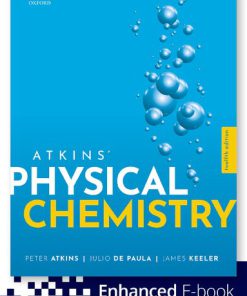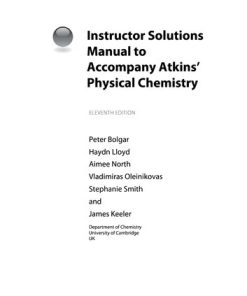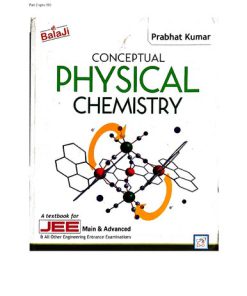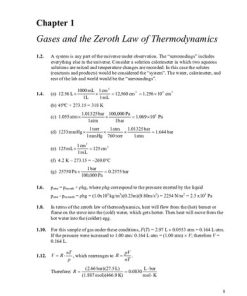Elements of Physical Chemistry 7th Edition by Peter Atkins, Julio de Paula ISBN 9780192522764 0192522760
$50.00 Original price was: $50.00.$25.00Current price is: $25.00.
Elements of Physical Chemistry 7th Edition by Peter Atkins, Julio de Paula – Ebook PDF Instant Download/Delivery: 9780192522764 ,0192522760
Full download Elements of Physical Chemistry 7th Edition after payment
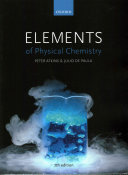
Product details:
ISBN 10: 0192522760
ISBN 13: 9780192522764
Author: Peter Atkins, Julio de Paula
Elements of Physical Chemistry 7th Edition Table of contents:
Focus 1 The properties of gases
1A The perfect gas
1A.1 The perfect gas equation of state
1A.2 Using the perfect gas law
1A.3 Mixtures of gases: partial pressures
Checklist of Key Concepts
1B The kinetic model of gases
1B.1 The pressure of a gas according to the kinetic model
1B.2 The root-mean-square speed of gas molecules
1B.3 The Maxwell distribution of speeds
1B.4 Diffusion and effusion
1B.5 Molecular collisions
Checklist of Key Concepts
1C Real gases
1C.1 Molecular interactions
1C.2 The critical temperature
1C.3 The compression factor
1C.4 The virial equation of state
1C.5 The van der Waals equation of state
1C.6 The liquefaction of gases
Checklist of Key Concepts
Exercises, discussion questions, problems, and projects
Focus 2 The First Law of thermodynamics
2A Work
2A.1 Systems and surroundings
2A.2 Expansion work
2A.3 Reversible expansion
Checklist of Key Concepts
2B Heat
2B.1 Conventions
2B.2 Heat capacity
2B.3 Calorimetry
2B.4 Heat influx during expansion
Checklist of Key Concepts
2C Internal energy
2C.1 The internal energy
2C.2 The internal energy as a state function
2C.3 Changes in the internal energy
2C.4 The molecular basis of the internal energy
Checklist of Key Concepts
2D Enthalpy
2D.1 The definition of enthalpy
2D.2 Changes in enthalpy
2D.3 The temperature dependence of the enthalpy
Checklist of Key Concepts
2E Physical change
2E.1 The enthalpy of phase transition
2E.2 Ionization and electron attachment
Checklist of Key Concepts
2F Chemical change
2F.1 Bond dissociation
2F.2 Enthalpies of combustion
2F.3 The combination of reaction enthalpies
2F.4 Standard enthalpies of formation
2F.5 The variation of reaction enthalpy with temperature
Checklist of Key Concepts
Exercises, discussion questions, problems, and projects
Focus 3 The Second Law of thermodynamics
3A Entropy
3A.1 The direction of spontaneous change
3A.2 Entropy and the Second Law
3A.3 Heat engines, refrigerators, and heat pumps
Checklist of Key Concepts
3B Entropy changes
3B.1 The entropy change accompanying a change in volume
3B.2 The entropy change accompanying a change in temperature
3B.3 The entropy change accompanying a phase transition
3B.4 Entropy changes in the surroundings
Checklist of Key Concepts
3C Absolute entropy
3C.1 The Third Law of thermodynamics
3C.2 The molecular interpretation of entropy
3C.3 Residual entropy
Checklist of Key Concepts
3D The Gibbs energy
3D.1 The standard reaction entropy
3D.2 The spontaneity of chemical reactions
3D.3 Focusing on the system
3D.4 Properties of the Gibbs energy
Checklist of Key Concepts
Exercises, discussion questions, problems, and projects
Focus 4 Physical transformations
4A The thermodynamics of transition
4A.1 The condition of stability
4A.2 The variation of Gibbs energy with pressure
4A.3 The variation of Gibbs energy with temperature
4A.4 The Gibbs–Helmholtz equation
Checklist of Key Concepts
4B Phase diagrams of pure substances
4B.1 Phase boundaries
4B.2 The location of phase boundaries
4B.3 Characteristic points
4B.4 The phase rule
4B.5 Phase diagrams of typical materials
Checklist of Key Concepts
4C Partial molar quantities
4C.1 Partial molar volume
4C.2 The chemical potential
4C.3 Spontaneous mixing
Checklist of Key Concepts
4D Solutions
4D.1 Ideal solutions
4D.2 The chemical potential of the solvent
4D.3 Ideal–dilute solutions
4D.4 The chemical potential of the solute
4D.5 Real solutions: activities
Checklist of Key Concepts
4E Colligative properties
4E.1 The modification of boiling and freezing points
4E.2 Osmosis
Checklist of Key Concepts
4F Phase diagrams of mixtures
4F.1 Mixtures of volatile liquids
4F.2 Liquid–liquid phase diagrams
4F.3 Liquid–solid phase diagrams
4F.4 Zone refining
4F.5 The Nernst distribution law
Checklist of Key Concepts
Exercises, discussion questions, problems, and projects
Focus 5 Chemical change
5A The thermodynamics of reaction
5A.1 The reaction Gibbs energy
5A.2 The variation of ΔrG with composition
5A.3 Reactions at equilibrium
5A.4 The standard reaction Gibbs energy
Checklist of Key Concepts
5B The equilibrium constant
5B.1 The composition at equilibrium
5B.2 The equilibrium constant in terms of concentration
5B.3 The molecular interpretation of equilibrium constants
Checklist of Key Concepts
5C Response to conditions
5C.1 The effect of temperature
5C.2 The effect of compression
5C.3 The presence of a catalyst
Checklist of Key Concepts
5D Proton transfer equilibria
5D.1 Brønsted–Lowry theory
5D.2 Protonation and deprotonation
Checklist of Key Concepts
5E Polyprotic acids
5E.1 Successive deprotonation
5E.2 Speciation
Checklist of Key Concepts
5F Acid–base equilibria of salts in water
5F.1 The pH of salt solutions
5F.2 Acid–base titrations
5F.3 Buffer action
Checklist of Key Concepts
5G Solubility equilibria
5G.1 The solubility constant
5G.2 The common-ion effect
5G.3 The effect of added salts on solubility
Checklist of Key Concepts
5H Ions in solution
5H.1 Mean activity coefficients
5H.2 The Debye–Hückel theory
5H.3 The migration of ions
Checklist of Key Concepts
5I Electrochemical cells
5I.1 Half-reactions and electrodes
5I.2 Reactions at electrodes
5I.3 Varieties of cell
5I.4 The cell reaction
5I.5 The cell potential
Checklist of Key Concepts
5J Standard potentials
5J.1 The contributions of individual electrodes
5J.2 Equilibrium constants from standard potentials
5J.3 The variation of potential with pH
5J.4 The electrochemical series
5J.5 The combination of standard potentials
5J.6 Thermodynamic data from standard potentials
Checklist of Key Concepts
Exercises, discussion questions, problems, and projects
Focus 6 Chemical kinetics
6A Empirical chemical kinetics
6A.1 The definition of rate
6A.2 Experimental techniques
Checklist of Key Concepts
6B Rate laws
6B.1 The rate constant
6B.2 Reaction order
6B.3 The determination of the rate law
Checklist of Key Concepts
6C Integrated rate laws
6C.1 Zeroth-order reactions
6C.2 First-order reactions
6C.3 Second-order reactions of the type A → products
6C.4 Second-order reactions of the type A + B → products
6C.5 Half-lives
Checklist of Key Concepts
6D The temperature dependence of reaction rates
6D.1 The Arrhenius parameters
6D.2 Collision theory of gas-phase reactions
6D.3 Transition-state theory
Checklist of Key Concepts
6E The approach to equilibrium
6E.1 Equilibria and rates
6E.2 Relaxation
Checklist of Key Concepts
6F Reaction mechanisms
6F.1 Elementary reactions
6F.2 The formulation of rate laws
6F.3 Consecutive reactions
6F.4 Pre-equilibrium
6F.5 The steady-state approximation
6F.6 The rate-determining step
6F.7 Kinetic control
6F.8 Unimolecular reactions
Checklist of Key Concepts
6G Reactions in solution
6G.1 Activation control and diffusion control
6G.2 Diffusion
Checklist of Key Concepts
6H Homogeneous catalysis
6H.1 The Michaelis–Menten mechanism of enzyme catalysis
6H.2 The analysis of rates of enzyme-catalysed reactions
Checklist of Key Concepts
6I Heterogeneous catalysis
6I.1 Physisorption and chemisorption
6I.2 Adsorption isotherms
6I.3 Mechanisms of surface-catalysed reactions
Checklist of Key Concepts
Exercises, discussion questions, problems, and projects
Focus 7 Quantum theory
7A The emergence of quantum theory
7A.1 The evidence for discrete energies
7A.2 The evidence for radiation as particles
7A.3 The evidence for particles as waves
Checklist of Key Concepts
7B The dynamics of microscopic systems
7B.1 The Schrödinger equation
7B.2 The Born interpretation
7B.3 The uncertainty principle
Checklist of Key Concepts
7C Translation
7C.1 Motion in one dimension
7C.2 Tunnelling
7C.3 Motion in two dimensions
Checklist of Key Concepts
7D Rotation
7D.1 Rotation in two dimensions
7D.2 Rotation in three dimensions
Checklist of Key Concepts
7E Vibration
7E.1 The harmonic oscillator
7E.2 The quantum mechanical treatment
Checklist of Key Concepts
Exercises, discussion questions, problems, and projects
Focus 8 Atomic structure
8A Hydrogenic atoms
8A.1 The permitted energies of hydrogenic atoms
8A.2 Quantum numbers
8A.3 The s orbitals
8A.4 The p and d orbitals
Checklist of Key Concepts
8B Many-electron atoms
8B.1 The orbital approximation
8B.2 Electron spin
8B.3 The Pauli principle
8B.4 Penetration and shielding
8B.5 The building-up principle
8B.6 The occupation of d orbitals
8B.7 The configurations of cations and anions
8B.8 Self-consistent field orbitals
Checklist of Key Concepts
8C Periodic trends of atomic properties
8C.1 Atomic and ionic radii
8C.2 Ionization energy and electron affinity
Checklist of Key Concepts
8D Atomic spectroscopy
8D.1 The spectra of hydrogenic atoms
8D.2 The energies of many-electron atoms
8D.3 Spin–orbit coupling
8D.4 Selection rules for many-electron atoms
Checklist of Key Concepts
Exercises, discussion questions, problems, and projects
Focus 9 The chemical bond
9A Valence bond theory
9A.1 Diatomic molecules
9A.2 Polyatomic molecules
9A.3 Promotion and hybridization
9A.4 Resonance
9A.5 The language of valence bond theory
Checklist of Key Concepts
9B Molecular orbital theory: homonuclear diatomics
9B.1 The construction of molecular orbitals
9B.2 Bonding and antibonding orbitals
9B.3 Inversion symmetry
9B.4 The chemical bond in molecular orbital theory
9B.5 Many-electron homonuclear diatomics
9B.6 The configurations of Period 2 homonuclear diatomics
9B.7 The criteria for building molecular orbitals
Checklist of Key Concepts
9C Molecular orbital theory: heteronuclear diatomics
9C.1 Polar bonds
9C.2 The formulation of molecular orbitals
9C.3 Molecular orbital diagrams
Checklist of Key Concepts
9D Molecular orbital theory: polyatomic molecules
9D.1 The molecular orbitals of H2O
9D.2 The Hückel method
9D.3 The molecular orbitals of benzene
9D.4 Computational chemistry
Checklist of Key Concepts
Exercises, discussion questions, problems, and projects
Focus 10 Molecular interactions
10A Electric properties of molecules
10A.1 Electric dipole moments
10A.2 Dipole moments of polyatomic molecules
10A.3 Polarizabilities
Checklist of Key Concepts
10B Interactions between molecules
10B.1 Interactions between partial charges
10B.2 Charge–dipole interactions
10B.3 Dipole–dipole interactions
10B.4 Dipole–induced dipole interactions
10B.5 Dispersion interactions
10B.6 Hydrogen bonding
10B.7 The hydrophobic effect
10B.8 Modelling the total interaction
Checklist of Key Concepts
Exercises, discussion questions, problems, and projects
Focus 11 Molecular spectroscopy
11A General features of molecular spectroscopy
11A.1 Spectrometers
11A.2 Absorption and emission
11A.3 Raman scattering
11A.4 Linewidths
Checklist of Key Concepts
11B Rotational spectroscopy
11B.1 The rotational energy levels of molecules
11B.2 Forbidden and allowed rotational states
11B.3 Populations at thermal equilibrium
11B.4 Microwave spectroscopy
11B.5 Rotational Raman spectra
Checklist of Key Concepts
11C Vibrational spectroscopy
11C.1 The vibrations of molecules
11C.2 Vibrational transitions
11C.3 Anharmonicity
11C.4 Vibrational Raman spectra of diatomic molecules
11C.5 The vibrations of polyatomic molecules
11C.6 Vibration–rotation spectra
11C.7 Vibrational Raman spectra of polyatomic molecules
Checklist of Key Concepts
11D Electronic spectroscopy
11D.1 Ultraviolet and visible spectra
11D.2 Specific types of transitions
11D.3 Analysis of mixtures by electronic spectroscopy
11D.4 Photoelectron spectroscopy
Checklist of Key Concepts
11E The decay of excited states
11E.1 Fluorescence and phosphorescence
11E.2 Mechanism of decay of excited states
11E.3 Quenching
11E.4 Resonance energy transfer
Checklist of Key Concepts
Exercises, discussion questions, problems, and projects
Focus 12 Statistical thermodynamics
12A The Boltzmann distribution
12A.1 The population of states
12A.2 The general form of the Boltzmann distribution
12A.3 The origins of the Boltzmann distribution
Checklist of Key Concepts
12B The partition function
12B.1 The interpretation of the partition function
12B.2 The molecular partition function
12B.3 The translational partition function
12B.4 The rotational partition function
12B.5 The vibrational partition function
12B.6 The electronic partition function
12B.7 The significance of the molecular partition function
Checklist of Key Concepts
12C The origin of thermodynamic properties
12C.1 The internal energy
12C.2 The heat capacity
12C.3 The entropy
12C.4 The Gibbs energy
12C.5 The equilibrium constant
Checklist of Key Concepts
Exercises, discussion questions, problems, and projects
Resource section
Part 1 Common integrals
Part 2 Units
Part 3 Data
Index
People also search for Elements of Physical Chemistry 7th Edition:
elements of physical chemistry 7th edition pdf
solutions manual to accompany elements of physical chemistry
solutions manual to accompany elements of physical chemistry 7e pdf
elements of physical chemistry pdf
Tags:
Peter Atkins,Julio de Paula,Elements,Physical Chemistry
You may also like…
Chemistry - Microchemistry
Uncategorized
Chemistry - Chemistry - General & Miscellaneous
Physical Chemistry of Polymers A Conceptual Introduction Sebastian Seiffert
Chemistry - Physical Chemistry
Chemistry - Physical Chemistry
Chemistry 3 introducing inorganic organic and physical chemistry 2nd Edition Burrows
Chemistry - Physical Chemistry






